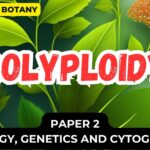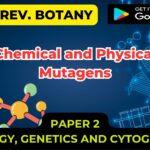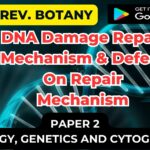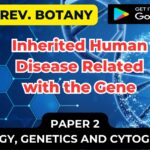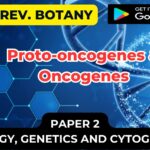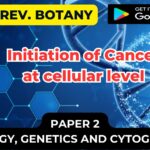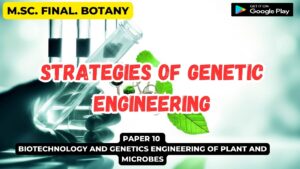Molecular Basis of Gene Mutation
Features of Molecular Mutations:
Main features of molecular mutations are given below:
1. It is a change in the number or arrangement of nucleotide sequence of a gene.
2. It is a heritable change in DNA sequence.
3. It is permanent structural change in hereditary material [DNA].
4. Mutations can be harmful, beneficial, or have no effect.
5. Mostly mutations are harmful and very rarely beneficial.
6. Mutations may be caused by mistakes during cell division, or they may be caused by- exposure to DNA-damaging agents in the environment such as radiation and mutagenic chemicals.
7. It is an alteration in a gene from its natural state. In other words, one allele of a gene changes into a different allele.
8. It may be a spontaneous or induced change in the DNA of a cell.
9. A mutation results in the appearance of a new heritable characteristic in an individual.
10. Mutations are sometimes attributed to random chance events.
Causes of Molecular Mutation:
Mutations in molecular terms are caused by two types of changes at the DNA level, viz:
(i) Base substitution, and
(ii) Base additions or deletions.
1. Base Substitution:
- The replacement of one base pair by another is called base substitution.
- Some mutations affect only a part of a nucleotide, resulting in replacement of base pair.
- The replacement of base pair may take place during replication of DNA without breakage.
- These base pair replacements are of two types, viz. transitions and transversions.
(i) Transition:
- Replacement of one purine by another purine or one pyrimidine by another pyrimidine is known as transition.
- In other words, it is the replacement of a base by other base of the same chemical group [purine replaced by purine: either A to G or G to A; pyrimidine replaced by pyrimidine: either C to T or T to C].
- It means that both way change between purines [A and G] and pyrimidines [C and T] can occur. Such type of change yields a normal base.
(ii) Transversion:
- Replacement of a purine by a pyrimidine and vice versa is called transversion.
- In other words, it is the replacement of a base of one chemical category by a base of the other [pyrimidine replaced by purine: C to A, C to G, T to A, T to G; purine replaced by pyrimidine: A to C, A to T, G to C, G to T].
- In transversion, either a base is converted into an abnormal base or is substituted by such base.
- These changes occur either due to mis-incorporation or mis- replication. Moreover, transitions are generally more frequent than transversions.
2. Base Addition or Deletion:
- Such mutations are the result of breaking the backbone of genetic material [DNA] at two or more places.
- Such alterations include, addition, deletion, replacement, transposition and inversion.
- All these mutations except inversions are possible for single stranded DNA or RNA.
- Inversion requires double stranded nucleic acid.
- The simplest forms of such mutations are single-base-pair additions or single-base-pair deletions.
- There are examples in which mutations arise through simultaneous addition or deletion of multiple base pairs.
- Like nonsense mutations, single-base additions or deletions have consequences on polypeptide sequence that extend far beyond the site of the mutation itself.
- Because the sequence of mRNA is “read” by the translational apparatus in groups of three base pairs (codons), the addition or deletion of a single base pair of DNA will change the reading frame starting from the location of the addition or deletion and extending to the carboxy terminal of the protein.
Types of Molecular Mutation:
1. Non-Sense Mutations:
- Mutations in which the codon for one amino acid is replaced by a translation termination (stop) codon are referred to as non-sense mutations.
- In non-sense mutation a stop codon replaces an amino acid codon, resulting in premature termination of nucleotide chain.
(i) Codon Involved:
- Non-sense mutations have non-sense codons which do not code for any amino acid.
(ii) Frequency:
- The frequency of non-sense mutations is much lower than missense mutations.
(iii) Effects:
- Non-sense mutations lead to the premature termination of polypeptide chain and hence are also called chain terminating mutations.
- They have a considerable effect on protein function.
- Generally, nonsense mutations will produce completely inactive protein products.
- When they occur very close to the 3′ end of the open reading frame, only a partly functional truncated polypeptide is produced.
(iv) Origin:
- Non-sense mutations result due to formation of non-sense codons after origin of frame shift mutations.
2. Missense Mutations:
- Mutations in which the codon for one amino acid is replaced by a codon for another amino acid are called missense mutations.
- Missense mutations result in a protein in which one amino acid is substituted for another.
(i) Codons Involved:
- Missense mutations have missense codons which code for different amino acid.
- Missense mutations usually result in replacement of a single amino acid in the polypeptide chain.
(ii) Frequency:
- The frequency of missense mutations is more than non-sense mutations.
(iii) Effects:
- The effects of such mutations vary. For example, if a missense mutation causes the substitution of a chemically similar amino acid, referred to as a synonymous substitution, then it is likely that the alteration will have a less-severe effect on the protein’s structure and function.
- If a missense mutation causes the substitution of a chemically different amino acid, called non-synonymous substitutions, then it is more likely to produce severe changes in protein structure and function.
(iv) Origin:
- Missense mutations result due to formation of missense codons after origin of frame shift mutations.
3. Silent Mutations:
- Mutations that code for the same or similar amino acid are known as silent mutations.
- Such mutations change one codon for an amino acid into another codon for that same amino acid.
- Hence such mutations never alter the amino acid sequence of the polypeptide chain. In other words, they do not have any effect.
4. Frame Shift Mutations:
- There is another category of point mutation in which the normal reading frame of the base triplet [codon] is changed.
- Such mutations are known as frame shift mutations.
- In these mutations, the normal reading frame of base triplets [codons] is altered due to addition or deletion of single base pair or nucleotides in mRNA.
- These are generally followed by a stop codon.
(i) Origin:
- The frame shift mutations arise due to addition or deletion of single base pair.
- They arise in two ways, viz:
(i) By error during DNA repair or replication, and
(ii) By acridine dyes.
- The addition or deletion of nucleotides occurs in numbers other than three or multiple of three.
- The reading frame in such case is shifted from the point of addition or deletion onwards.
(ii) Position:
- The addition or deletion of base pairs takes place in interstitial or intercalary position.
- Sometimes, addition and deletions take place at the same position, they are known as double frame shifts.
- Such changes may restore the normal reading frame in mRNA.
(iii) Effects:
- Frame shift mutations typically exhibit complete loss of normal protein structure and function.
- After frame shift mutations, three types of codons are produced, viz:
(i) Sense codons,
(ii) Missense codons, and
(iii) Non-sense codons.
- Sense codons are normal codons which are read in the same way as before frame shift mutations.
- Mutations also effect the gene regulation both in eukaryotes and prokaryotes.
5. Induced and Spontaneous Mutation:
- Generally mutations are classified as induced and spontaneous.
- Induced mutations are defined as those that arise after purposeful treatment with mutagens.
- Spontaneous mutations are those that arise in the absence of known mutagen treatment.
- The frequency at which spontaneous mutations occur is low, generally in the range of one cell in 105 to 108.
- Therefore, if a large number of mutants is required for genetic analysis, mutations must be induced.
- The induction of mutations is accomplished by treating cells with mutagens.
- The mutagens most commonly used are high-energy radiation or specific chemicals. Induced and spontaneous mutations arise by generally different mechanisms.
Mechanisms of Induction Mutation :
Induced mutations are developed through the application of mutagenic agents called mutagens.
There are three different mechanisms of mutation induction through use of mutagens, viz. by:
(i) Base replacement,
(ii) Base alteration, and
(iii) Base damage in the DNA.
These are briefly discussed as follows:
1. Base Replacement:
- Some chemical compounds replace a base in the DNA because they are very similar to DNA bases. Such chemical compounds are called base analogues.
- They are sometimes incorporated into DNA in place of normal bases.
- Thus they can produce mutations by wrong base pairing.
- An incorrect base pairing results in transitions or transversions after DNA replication.
- The most commonly used base analogues are 5 bromo uracil [5BU] and 2 amino purine [2AP].
- The 5 bromo uracil is similar to thymine, but it has bromide at the C5 position, ‘whereas thymine has C3 group at C5″position.
- The presence of bromine in 5BU enhances its tautomeric shift from keto form to enol form.
- The keto form is usual and more stable form, while enol form is rare and less stable or short lived.
- Tautomeric change takes place in all the four DNA bases, but at a very low frequency.
- The change or shift of hydrogen atoms from one position to another either in a purine or in a pyridine base is known as tautomeric shift and such process is known as tautomerization.
- The base which is produced as a result of tautomerizationis known as tautomeric form or tautomer.
- As a result of tautomerization, the amino group [-NH2] of cytosine is converted into imno group [-NH], Similarly, keto group [C=O] of thymine is changed to enol group [-OH].
- 5BU is similar to thymine, therefore, it pairs with adenine [in place of thymine],
- A tautomer of 5BU will pair with quanine rather than with adenine.
- Since the tautomeric form is short lived, it will change to keto form at the time of DNA replication which will pair with adenine in place of guanine.
- In this way, it results in A to G or G to A; and C to T or T to C transitions.
- The mutagen 2AP acts in a similar way and causes A to G or G to A and T to C or C to T transitions.
- This is an analogue of adenine that can pair with thymine but can also mispair with cytosime and cause transitions.
2. Base Alteration:
- Some chemical compounds alter a DNA base so that it specifically mis-pairs with another base. Such mutagens are not incorporated into the DNA but instead alter a base, causing specific mis-pairing.
- Certain alkylating agents, such as ethyl methane sulphonate (EMS) and the widely used nitrosoguanidine (NG), operate by this pathway:

- They induce mutations especially transitions and transversions by adding an alkyl group [either ethyl or methyl] at various positions in DNA.
- Alkylation induces mutation by changing hydrogen bonding in various ways.
- Alkylating agents can cause various large and small deformations of base structure resulting in base pair transitions and transversions.
- Transversions can occur either because a purine has been so reduced in size that it can accept another purine for its complement, or because a pyridine has been so increased in size that it can accept another pyrimidine for its pairing.
- In both cases, diameter of the mutant base pair is close to that of a normal base pair.
3. Base Damage:
- Some mutagens damage a DNA base so that it can no longer pair with any base under normal conditions.
- A large number of mutagens damage one or more DNA bases, as a result no specific base pairing is possible.
- The result is a replication block, because DNA synthesis will not proceed beyond a base that cannot specify its complementary partner by hydrogen bonding.
- In bacterial cells, such replication blocks can be bypassed by inserting nonspecific bases.
- The process requires the activation of a special system, the SOS system the name SOS comes from the idea that this system is induced as an emergency response to prevent cell death in the presence of significant DNA damage.
- SOS induction is a last resort, allowing the cell to trade death for a certain level of mutagenesis.
- In nature DNA can be damaged by two main sources, viz. Ultraviolet light and Aflatoxin found in fungal infected peanuts.
- Ultraviolet (UV) light generates a number of photoproducts in DNA.
- Two different lesions that unite adjacent pyrimidines in the same strand have been most strongly correlated with mutagenesis.
- These lesions are the cyclobutane pyrimidine photodimer and the 6-4 photoproduct.
- These lesions interfere with normal base pairing; hence, induction of the SOS system is required for mutagenesis.
- The insertion of incorrect bases across from UV photoproducts is at the 3′ position of the dimer, and more frequently for 5′-CC-3′ and 5′- TC-3′ dimers.
- The C -> T transition is the most frequent mutation, but other base substitutions (transversions) and frame shifts also are induced by UV light, as are larger duplications and deletions.
- Aflatoxin B1 (AFB1) is a powerful carcinogen originally isolated from fungal-infected peanuts.
- Aflatoxin forms an addition product at the N-7 position of guanine.
- This product leads to the breakage of the bond between the base and the sugar, thereby liberating the base and resulting in an apurinic site.
- Studies with apurinic sites generated in vitro have demonstrated that the SOS bypass of these sites leads to the preferential insertion of an adenine across from an apurinic site.
- This predicts that agents that cause depurination at guanine residues should preferentially induce G C à TA transversions.

